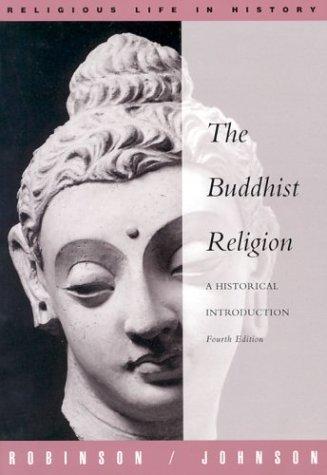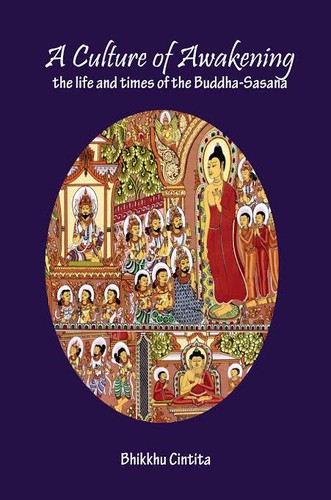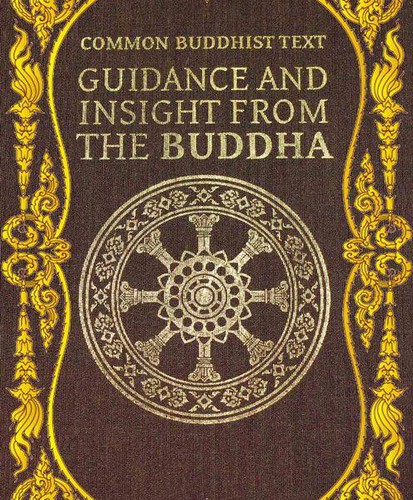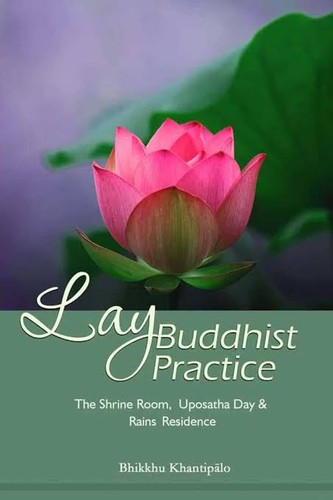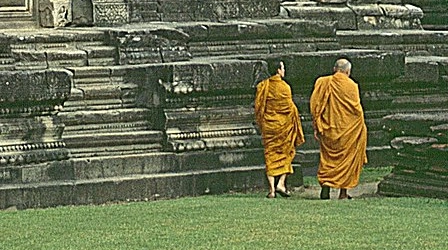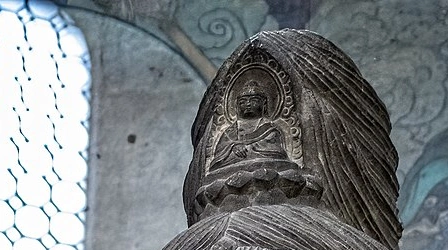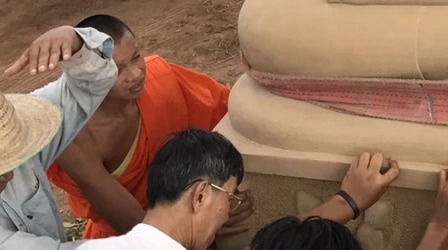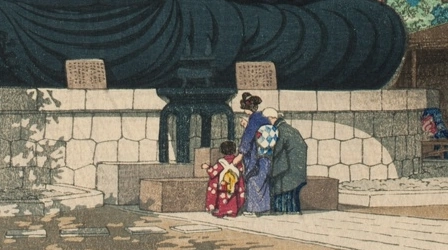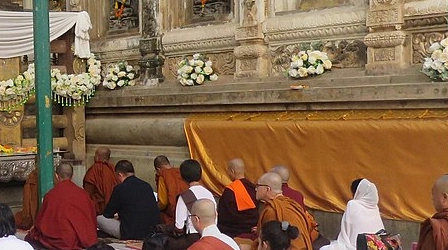The Buddhist Religion
Also available: As a Syllabus
Subscribe to this topic via: RSS
The social, historical, and cultural aspects of Buddhism as a religion.
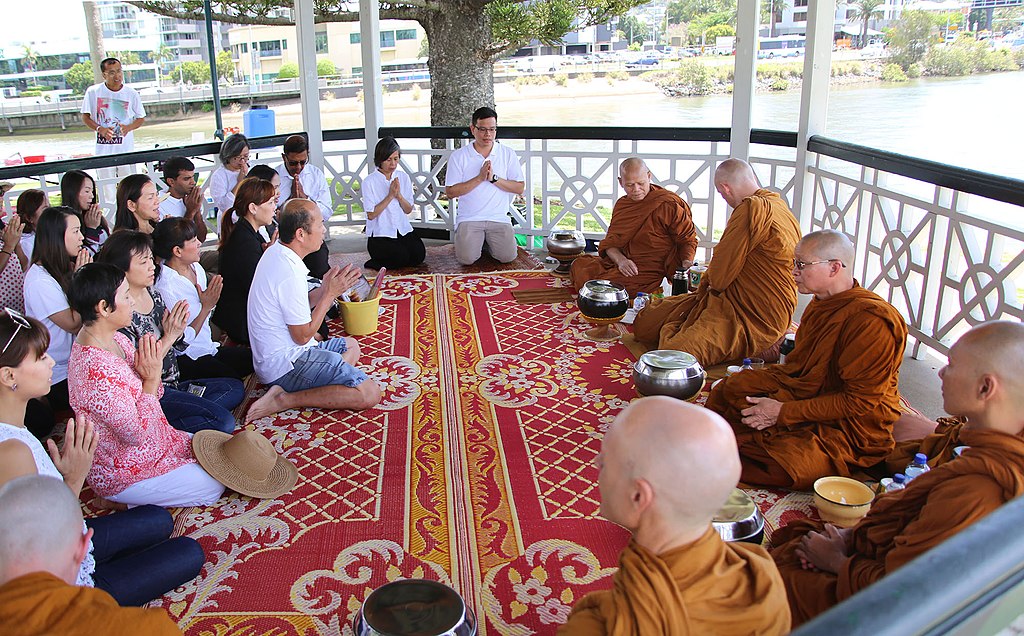
A group of lay people dressed mostly in white chant a formal meal invitation to a group of brown-robe-clad monks at an event in Australia in 2017. Despite its reputation as a "philosophy," Buddhism has rituals, traditions, and communities like any other lived religion. (Gary A Collett, CC BY-SA 4.0)
Table of Contents
- Books (20)
- Canonical Works (27)
- Readings (79)
- Audio/Video (45)
- Reference Shelf (1)
- Related Topics (6)
Books (20)
Featured:
-
⭐ Recommended314 pages
-
⭐ Recommended
-
⭐ Recommended
-
The dhamma-cakka, the ever moving Wheel of Law, is the most prominent symbol of the Buddhists.
See also:
Canonical Works (27)
Featured:
-
⭐ Recommended
This is how a disciple of the noble ones dwells
-
Mendicants, I’m not even comfortable thinking about a place where mendicants argue…
-
The Buddha criticizes violent sacrifice, but praises giving, especially to ethical mendicants.
-
A simple, four line dedication prayer from the Nyingma Tradition.
-
I arranged those flowers beautifully while recollecting the great qualities of the Supreme Buddha.
See also:
Readings (79)
Featured:
-
… the deed in the early text [MN135] is simply stated to be the killing, or refraining from killing, of living beings, and so on. The specific types of actions, and their approval are not mentioned. In the [later] Sanskrit text we get a list of normally around ten causes that lead to the result, many of which are illustrated
-
Discriminatory views and practices are the antithesis of Right View, and they undermine the Middle Path by perpetuating identification with concepts of independent, constant, inherently existing selves and others
-
🥇 Best of
The four toraṇas, or gateways, [put] the stūpa, symbolically, at the place where four roads meet, as is specified in the Mahāparinibbāna Sutta.
-
🥇 Best of
I would say that the Nikāyas and Āgamas give us a “historical-realistic perspective” on the Buddha, while the Mahāyāna sūtras give us a “cosmic-metaphysical perspective.”
-
Explains the strange way that Buddhists proselytize.
-
Just as the beautiful lotus blossom grows up from the mud and water, so one with an enlightened mind develops out of the ranks of ordinary beings
35 pages -
… the alleged, extraordinary natures of such powerful relics and images compelled certain individuals to narrate and recount how they were found or made, where they traveled, and the various miracles they performed as a testament to their great power
28 pages -
On trying to place Buddhist altruism in conversation with altruism as understood by the Western philosophical tradition.
-
a comprehensive list of meditation techniques.
-
⭐ Recommended
fearing that the merchants would throw the Sūtras and Buddha’s portraits overboard, I concentrated with all my heart on Guanshiyin
-
… valuable material for the contemplation of the transit of ideas between South Asia and Korea
-
A brief, visual history of the Theravāda stupa.
-
Buddhism’s second step in becoming a world religion occurred during the reign of King Kaniska (r. 130?–155?, or 78?–103?) of the Kushan Empire as the religion spread into Central Asia.
-
Buddhist denominations sought to inspire Koreans to become reacquainted with cultural heritage and internationals to learn about Buddhism. Temple stays were and continue to be promoted as a way to find one’s “true self” […] This burgeoning tourism niche attracted 70,910 internationals in 2017
-
⭐ Recommended
Just as I was talking about the unhindered Light,
In rolled the morning fog -
… the effects of a brief mindfulness program for emotional regulation and levels of mindfulness on senior students in Brazil.
-
The monks themselves play an integral part in the social and moral education and support the social development of the village people of northern Cambodia.
-
⭐ Recommended
An intriguing (re)definition of religion, science, and culture.
-
🥇 Best of
Ajahn Geoff explains how the monastic institution works by creating an economy of gifts.
3 pages -
⭐ Recommended
What impresses me most about that encounter is how unimpressive it was.
-
The History of Buddhist Monasticism and Its Western Adaptation (1999) – Bhikshuni Karma Lekshe Tsomo
The general public, including Western Buddhists themselves, often assumes that Buddhist monastics are cared for by an order, as are Christian monastics, and are surprised to learn that newly-ordained Western nuns and monks may be left to deal with issues of sustenance completely on their own.
-
… when counterfeit dhamma appears, the true Dhamma disappears, in the same way that when counterfeit money appears, true money disappears.
-
The earliest Buddhist texts don’t actually say much about the Buddha, and don’t include most of the popular legends about his life.
-
The lotus is rooted and grows in the slimy mud at the bottom of a pond. As it moves upward and blossoms forth, the white lotus is untainted by the mud of the Earth. Likewise, the successful monk emerges clean and purified of the world
-
Nagarjuna uses concepts to undermine the thought-constructed ways in which we understand the world
-
Amida Buddha emerged in Mahayana Buddhism from among the multitude of Buddhas, Bodhisattvas, or other Indian divine beings to become the primary expression of Unconditional Compassion and Universal Wisdom [for Pure Land Buddhists]
-
Pure Land Buddhists in America seek to create a Pure Land here on Earth through ritual acts of devotion, care for animals and human beings, study, meditation, and acting compassionately in the public sphere.
-
In Southern California, some Theravāda temples have taken up the practice of granting temporary novice ordinations to Cambodian American gang members, with the hope of reorienting the youth toward their families’ religion and culture.
-
Mudras are hand positions often depicted in Buddhist art and used in practice to evoke a particular state of mind. The most notable mudras (Sanskrit for “seal”) are those commonly found in representations of the Buddha.
-
Buddhists have a variety of ceremonies for dedicating merit to their ancestors.
-
Because of the difficulty of understanding the more abstruse concepts of Buddhism, popular Buddhism took over and modified Indian mythology
-
⭐ Recommended
A beautiful sermon on the value of monasticism.
-
Chanting is a form of meditation practiced by nearly all the Buddhist traditions.
-
The Tibetan term for mandala, kyinkor, means ‘center and surrounding environment.’ The center with its surrounding geometric designs, its doors, its guardians, and its gods—all become charged with the order and the energy of the whole cosmos.
-
A short description of koan meditation practice.
-
The sesshin is designed to enable one to plunge ahead in one’s practice.
-
… you can’t escape them
See also:
Audio/Video (45)
Featured:
-
⭐ Recommended

-
A few tips on recognizing and practicing authentic Buddhism.
-

-
🥇 Best of
A lonely temple, nestled in the mountains of central Taiwan, says goodnight.
-
⭐ Recommended
In themselves, the forms are indeed empty and many of them are utterly arbitrary, but they are also profound and precious.
-
Bhante Yuttadhammo revisits the Gotami Sutta (which you may remember from the Intro to Buddhism Course) and tells us how we can recognize when our own practice of Buddhism goes off track.
-

-
The essence (as opposed to the expressions) of Buddhism. A lovely introduction.
-

-
In the early 1970s, a young Sri Lankan boy named Dhammaruwan spontaneously recalled huge amounts of Pāli chanting. Eventually, his father gave the boy a tape recorder, and this haunting, beautiful chant was recorded some evening later. Recently, textual scholarship by Analayo Bhikkhu has suggested the memory may be from over a thousand years ago (see Rebirth in Early Buddhism).
-
 24 min
24 min -
⭐ Recommended
A word for the centrality of medicine in the spread and practice of Buddhism.
-
 23 min
23 min -
 20 min
20 min -
The story behind this odd, ancient statue
-
 13 min
13 min -
 10 min
10 min -
 9 min
9 min -
 6 min
6 min -

-
A very short video, explaining the symbolism behind a common, Tibetan Buddha statue.
See also:
Reference Shelf (1)
-
A fairly comprehensive atlas of known archeological sites containing evidence of medieval Buddhists showing the spread of Buddhism across Asia.
